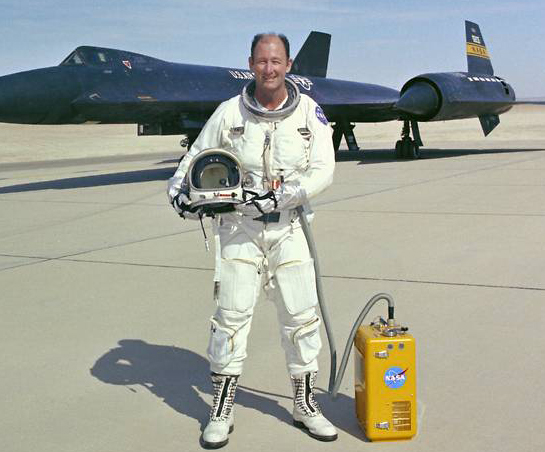
Fitzhugh L. Fulton, Jr.
NASA Pilot
Fitzhugh L. Fulton, Jr. was a civilian research pilot at NASA’s Dryden (now Armstrong) Flight Research Center, Edwards, CA, from August 1, 1966, until July 3, 1986, following 23 years of service as a pilot in the U.S. Air Force.
Fulton was the project pilot on all early tests of the 747 Shuttle Carrier Aircraft (SCA) used to air launch the Space Shuttle prototype Enterprise in the Approach and Landing Tests (ALT) at Dryden in l977. During these flights, the SCA carried the unpowered Enterprise to an altitude of about 25,000 feet, where it was separated from the 747 and flown to a landing by the Shuttle test crew. Several uncrewed and crewed captive flights preceded the initial free-flights.
For his work in the ALT program, Fulton received NASA’s Exceptional Service Medal. He also received the Exceptional Service Medal again in 1983 for flying the 747 SCA during the European tour of the Space Shuttle Enterprise. After orbital flights began in 1981, Fulton continued to fly the SCA during ferry missions returning Orbiters to the Kennedy Space Center, FL.
During his career at Dryden, Fulton was project pilot on NASA’s B-52 launch aircraft used to air launch a variety of piloted and unmanned research aircraft, including the X-15s and lifting bodies, as well as project pilot on the Laminar Flow Control Leading Edge research program using a specially modified C-140 JetStar.
He flew the XB-70 prototype supersonic bomber on both NASA-USAF tests and NASA research flights during the late 1960s, attaining speeds exceeding Mach 3. He was also a project pilot on the YF-12A and YF-12C research program from April 14, 1969, until September 25, 1978. The planes were flown at speeds and altitudes in excess of 2,000 mph and 70,000 feet to acquire flight data for the development of future aircraft.
Fulton was the project pilot for the FAA/NASA Controlled Impact Demonstration program during 1984. It culminated on December 1, 1984, when he remotely flew an unmanned, heavily instrumented Boeing 720 to a prepared impact point on Rogers Dry Lake to test the flammability of anti-misting jet fuel in a crash situation.
Before becoming a NASA research pilot Fulton was a test pilot with the Air Force. He was a project pilot on the B-58 supersonic bomber program and set an international altitude record of 85,360 feet with the aircraft carrying a payload of 11,023 pounds (5000 kilograms) in 1962. He received the 1962 Harmon International Aviation Trophy for his work on the program.
Fulton was also assigned as the Air Force pilot on the B-52 launch aircraft for the X-15 research aircraft and other air-launched vehicles.
During his earlier Air Force career Fulton received three Distinguished Flying Cross medals for his test pilot work. He also received a Distinguished Flying Cross and five Air Medals for flying 55 missions in Korea and taking part in the the Berlin Airlift.
Fulton attended Auburn University, the University of Oklahoma, and is a graduate of Golden Gate University. He completed the Air Force Experimental Test Pilot School in 1952. He is a Fellow of the Society of Experimental Test Pilots, and in 1977 received the Society’s Iven C. Kincheloe Award as Test Pilot of the Year for his work on the ALT program. At the time of his NASA retirement, Fulton had over 15,000 flying hours in over 200 types of aircraft.

























